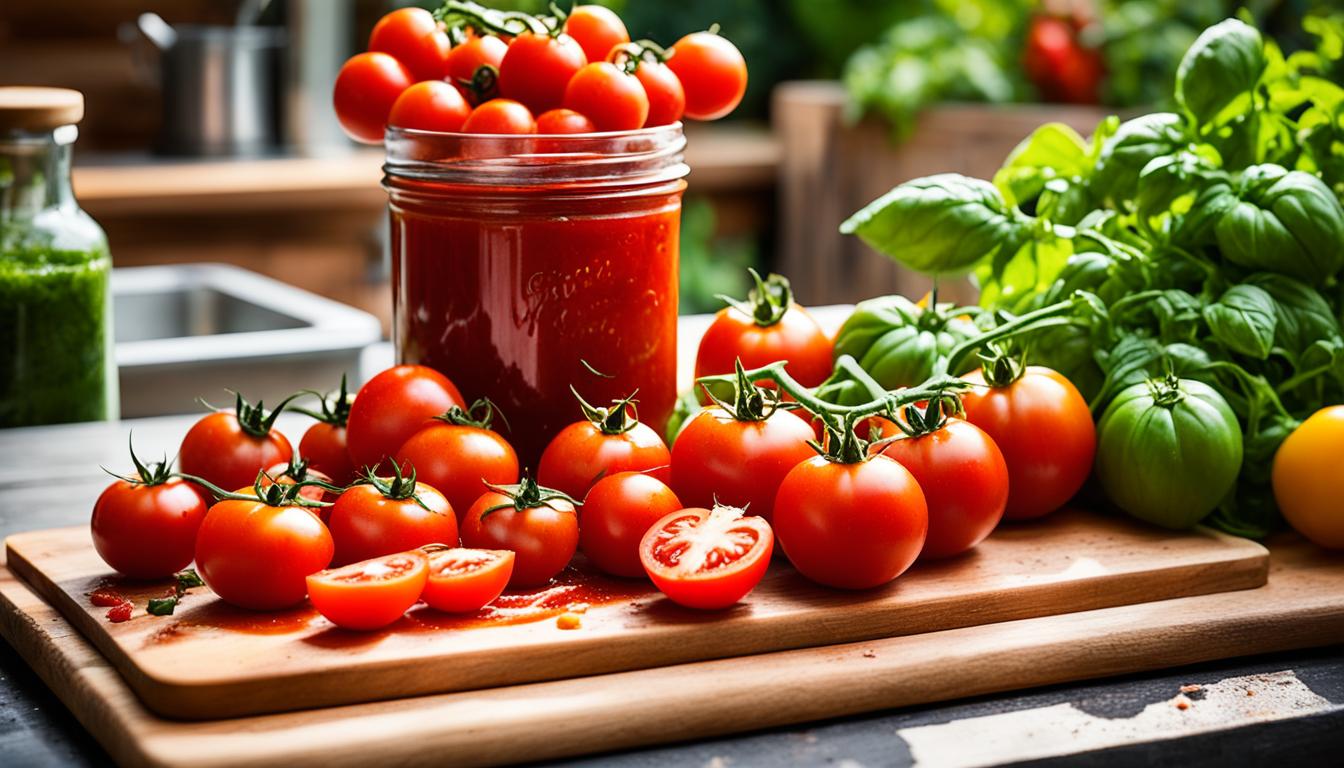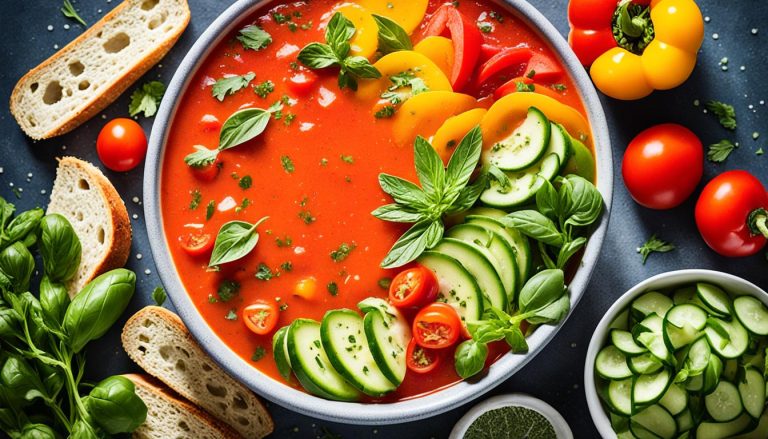Imagine sitting in your grandmother’s kitchen, the aroma of ripe tomatoes filling the air. A pot of simmering, homemade passata on the stove, ready to be transformed into a mouthwatering pasta sauce. The memories flood back, the flavors linger on your taste buds, and you can’t help but smile.
There’s something truly special about homemade passata. It’s not just a sauce; it’s a labor of love, a connection to tradition, and a celebration of the vibrant flavors of summer. When you make your own passata, you’re capturing the essence of ripe tomatoes at their peak, preserving their freshness and enhancing their natural sweetness.
In this article, we’ll guide you step-by-step through the process of making homemade passata, sharing our traditional recipe and exciting variations to suit your taste. You’ll discover the joy of creating your own easy passata sauce, and how it can elevate your dishes to new heights of deliciousness.
So, let’s embark on this culinary adventure together, and unlock the secrets of homemade passata. Get ready to immerse yourself in the world of flavors, textures, and aromas that this timeless sauce has to offer.
Ingredients and Equipment
When it comes to making your own passata at home, you’ll only need two simple ingredients: fresh and ripe tomatoes, and salt. The secret to achieving the best flavor is using the highest quality tomatoes available. Opt for garden tomatoes or organic ones for that extra burst of freshness.
Along with the tomatoes, you’ll also need a few essential pieces of equipment to make the passata-making process a breeze:
- A tomato strainer machine or a blender: This will help you achieve a smooth consistency for your passata. Whether you choose a dedicated tomato strainer machine or a blender, both methods work effectively.
- A large stainless steel pot: This is where the magic happens. The pot should be large enough to accommodate the tomatoes and allow for easy stirring as they cook down.
- A sieve or clean cloth/tea towel: This will help you strain out any seeds or skins from the tomatoes, ensuring a silky smooth passata.
- Sterilized jars: After making your homemade passata, you’ll need airtight jars or bottles for storing it. Make sure to sterilize them properly to maintain the freshness and longevity of your passata.
Now that you have all the ingredients and equipment ready, it’s time to dive into the step-by-step instructions for making delicious homemade passata.

Ingredients and Equipment
| Ingredients | Equipment |
|---|---|
| Fresh and ripe tomatoes | Tomato strainer machine or blender |
| Salt | Large stainless steel pot |
| Sieve or clean cloth/tea towel | |
| Sterilized jars |
Instructions for Making Passata
Making your own passata at home is a satisfying and rewarding process. By following these step-by-step instructions, you can create a delicious batch of homemade passata that will elevate your dishes to new heights. Remember, patience and attention to detail are key to achieving the best results. Let’s get started!
1. Select and Prepare the Tomatoes
Begin by choosing fresh, ripe tomatoes for your passata recipe. Opt for juicy varieties such as Roma, San Marzano, or heirloom tomatoes for the best flavor. Wash the tomatoes thoroughly under cool running water to remove any dirt or debris.
Next, remove the green stems and any blemishes from the tomatoes. If desired, make a small “x” shaped incision on the bottom of each tomato to help with the skinning process.
2. Skin and Seed the Tomatoes
To remove the skins from the tomatoes, blanch them in boiling water for about 30 seconds, then transfer them to a bowl of ice water to cool quickly. Once cooled, the skin should easily peel off. Alternatively, you can use a tomato peeler for this step.
After peeling the tomatoes, gently squeeze or scoop out the seeds. Discard the seeds and set aside the skinned tomatoes for the next stage.
3. Cook the Tomatoes
In a large stainless steel pot, add the skinned and seeded tomatoes. Bring the tomatoes to a gentle simmer over medium heat, stirring occasionally to prevent sticking or burning. Allow the tomatoes to cook for about 30-45 minutes, or until they become soft and begin to break down.
During the cooking process, you can add a pinch of salt to enhance the natural flavors of the tomatoes. However, be mindful not to oversalt as the passata will continue to reduce, intensifying the saltiness.
4. Passata Preparation
Once the tomatoes are thoroughly cooked, it’s time to turn them into passata. There are two common methods for achieving this:
- Straining Method: Pass the cooked tomatoes through a tomato strainer machine or a fine-mesh sieve, gradually pressing down to extract the juice and separate it from the pulp and seeds.
- Blending and Sieving Method: Blend the cooked tomatoes in a blender or food processor until smooth. Then, strain the blended mixture through a fine-mesh sieve or a clean cloth/tea towel to remove any remaining seeds or pulp.
Choose the method that suits your preference and equipment availability, as both methods result in a smooth and flavorsome passata.
5. Bottle and Store
Once you have strained or blended and sieved the passata, it’s time to bottle and store it. Sterilize glass jars and lids by boiling them in hot water for a few minutes or using a dishwasher’s high-temperature setting.
Pour the hot passata into the sterilized jars, leaving a small gap at the top to allow for expansion during freezing or canning. Seal the jars tightly and allow them to cool completely before storing them in the refrigerator or freezer, depending on your desired shelf life.
Remember to label each jar with the date of preparation to keep track of freshness.
And there you have it! Your homemade passata is now ready to be used in a wide range of recipes, adding a burst of fresh tomato flavor to your culinary creations.

Tips for the Best Passata
- Use ripe and flavorful tomatoes to ensure a rich and vibrant passata.
- Experiment with different tomato varieties to discover your preferred flavor profile.
- Take your time to remove the tomato skin and seeds for a smoother consistency.
- Adjust the cooking time and temperature to achieve your desired passata thickness.
- Consider adding herbs or spices such as basil, oregano, or garlic for a personalized touch.
- Store passata in small jars or ice cube trays to easily portion out for future use.
Storage and Uses of Passata
Once you have made your homemade passata, it is important to store it properly to maintain its freshness and flavor. Here are some storage tips to ensure your passata stays delicious for longer:
- Freezing: Store your passata in airtight containers or freezer bags and freeze for up to 6 months. This is a great option if you have made a large batch and want to enjoy passata throughout the year.
- Fridge: For shorter-term use, you can store your passata in the fridge for up to 7 days. Transfer it to a clean, covered container to prevent any odors from contaminating the sauce.
- Vacuum Sealing: To extend the shelf life of your passata, consider investing in a vacuum sealer. This method removes all the air from the packaging, preserving the sauce for up to a year.
Now that you know how to store your passata, let’s explore the various uses of this versatile tomato sauce:
- Pasta Sauces: Passata is a perfect base for traditional pasta sauces like marinara, bolognese, or arrabbiata. Simply combine passata with herbs, spices, and your choice of meat or vegetables for a delicious pasta topping.
- Pizza Sauce: Use passata as a base for your homemade pizza sauce. Add your favorite herbs, garlic, and a touch of olive oil to create a flavorful topping for your pizzas.
- Soups and Stews: Passata adds depth and richness to soups and stews. Whether it’s a comforting tomato soup or a hearty beef stew, passata enhances the flavors and brings a vibrant color to your dishes.
- Baked Dishes: Incorporate passata into dishes like lasagna, baked ziti, or stuffed peppers for a burst of tomato goodness. The sauce adds a delightful tang and helps bind the ingredients together.
- Savory Sauces: Passata can be transformed into savory sauces for meat or seafood dishes. Use it as a base for meatballs, braised meats, or even as a dipping sauce for fish or shrimp.
As you can see, passata is a valuable ingredient in the kitchen, offering endless possibilities to elevate your dishes. Experiment with different recipes and enjoy the rich flavors and versatility of homemade passata!

| Storage Method | Duration |
|---|---|
| Freezing | Up to 6 months |
| Fridge | Up to 7 days |
| Vacuum Sealing | Up to 1 year |
Conclusion
In conclusion, making homemade passata is a rewarding culinary endeavour that allows you to capture the essence of fresh tomatoes and enhance the flavour of your dishes. This article has provided a detailed passata recipe, including variations to customise the flavour, storage tips, and various uses for passata in cooking. Whether you are a seasoned chef or a novice in the kitchen, making your own passata will elevate your dishes and bring a taste of authentic Italian cuisine to your table.
By following the step-by-step instructions and experimenting with different passata variations, you can create a passata sauce that suits your taste preferences. From the classic passata recipe to unique variations like adding herbs or spices, the possibilities are endless. Whether you prefer a chunky passata or a smooth consistency, there’s a method to suit your cooking style.
Once you have mastered the art of making passata, you can explore its versatility in various dishes. Use it as a base for rich pasta sauces, add it to your favourite pizza recipe for a burst of flavour, or incorporate it into hearty stews and soups. Passata can even be used as a delicious marinade for meats or seafood, adding depth and complexity to your dishes.
So why not take a trip to your local farmers market or grocery store, grab some ripe tomatoes, and embark on your passata-making adventure? With its vibrant colour, robust flavour, and versatility, homemade passata will elevate your cooking and impress your family and friends. Get creative, explore different passata variations, and discover the joy of homemade sauce that truly captures the essence of the tomato.
FAQ
Can I use any type of tomatoes to make passata?
It is recommended to use the best quality tomatoes, such as garden tomatoes or organic ones, for the best flavor.
How long does it take to make passata?
Making passata can be a time-consuming activity, but the end result is well worth the effort.
How do I store homemade passata?
Passata can be stored by freezing it in airtight containers, keeping it in the fridge for shorter-term use, or creating a vacuum seal to preserve it for longer periods.
What can I use passata for?
Passata can be used as a base for pasta sauces, pizza sauce, soups, stews, baked dishes, and savory sauces for meat or seafood.









